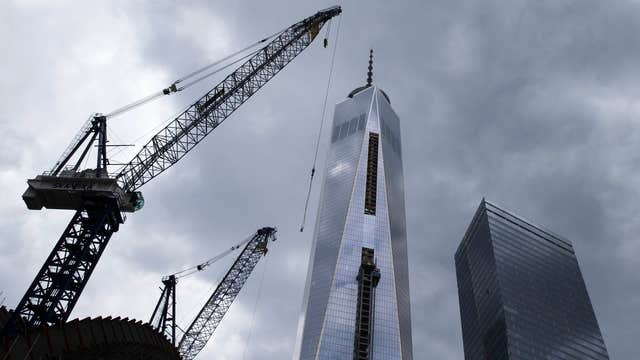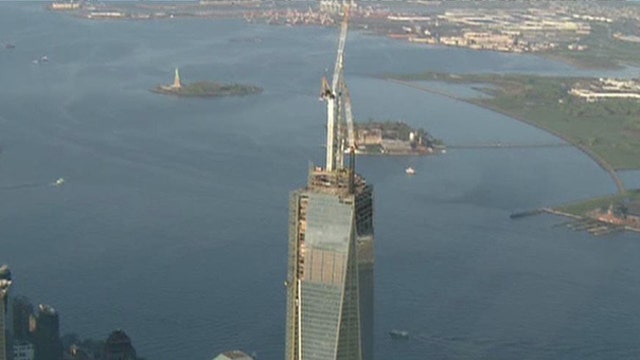Rebuilt after 9/11, One World Trade Center is 90% filled after cost overruns and delays
The entire World Trade Center complex hasn’t made a profit since One World Trade opened seven years ago
An inside-look at One World Trade Center’s ultimate comeback
One World Trade Center’s comeback
One World Trade Center, the 1,776-foot office building that rose in place of the Twin Towers destroyed on Sept. 11, cost $3.8 billion and is the most expensive skyscraper ever built in the U.S.
The entire World Trade Center complex hasn’t made a profit since One World Trade opened seven years ago, according to the building’s owner, the Port Authority of New York and New Jersey. In 2020, World Trade Center expenses of $335 million topped revenues of $328 million, the Port Authority’s annual report said.
THE BUSINESS OF HOMELAND SECURITY THRIVES IN THE TWO DECADES SINCE 9/11
Leasing was slow for years, partly because One World Trade faced pushback from potential tenants put off by an association with the terrorist attack, says Douglas Durst, a private developer brought in by the Port Authority in 2010 to try to help fill the tower.
"When we had negotiations with larger tenants, there was always one person involved who said they’re uncomfortable being on the site," Mr. Durst said. "So we ended up leasing to smaller tenants, where the CEO was able to tell people: ‘If you don’t want to come here, you don’t have to.’ "
But attitudes toward working at the World Trade Center are now changing due to a generational shift in the workplace, businesses say. Many workers today were so young on Sept. 11, 2001, they may see it as a distant historical event, not a personal threat.
"I don’t think most young people think about the WTC as being dangerous," said Tyler Fogatt, a 26-year-old senior editor at the New Yorker, using the shorthand to describe the World Trade Center.
"When I interviewed at the New Yorker and I found out I had to go to One WTC, I thought it was the coolest thing in the world," she said. "I didn’t think twice" about its association with 9/11.
The building has leased more than 90% of its 3.1 million square feet, which puts it on par with other modern office towers in downtown Manhattan, Mr. Durst said. It also helped that the tower’s owner in 2009 ditched the building’s original Freedom Tower name, which many felt was too emotionally charged and a reminder of that September morning.
These days, Mr. Durst added, the subject of Sept. 11 rarely comes up. "We don’t hear much about it any more," he said.
GET FOX BUSINESS ON THE GO BY CLICKING HERE
The fear among potential tenants receded, brokers say, as nearby buildings rose, the fences keeping the public at bay came down, and the new World Trade Center began to resemble a modern office complex more than a construction site.
The site also received government subsidies that made it less expensive for tenants to lease than comparable space, according to Lynne Sagalyn, author of "Power at Ground Zero," a book about the rebuilding effort.
The 16-acre site that once housed the World Trade Center towers and five other buildings is now home to a Sept. 11 memorial and museum, a transportation hub named the Oculus designed by Santiago Calatrava, a mall and three office buildings, including One World Trade.
A performing arts center and Greek Orthodox Church, intended to replace the one destroyed on Sept. 11, are under construction and expected to open in 2023. Two other office buildings and a residential tower are planned but construction hasn’t started.
After Sept. 11, the tower’s redevelopment was ensnared in legal, financial and political battles. Debates over what was due in insurance proceeds and how to memorialize the victims added further complications.
In 2003, New York City and state leaders selected a masterplan by the Polish-born architect Daniel Libeskind, which struck a balance between remembrance and rebuilding a commercial hub. The plan drew praise from architects and urban planners for restoring streets to the site that had been eliminated by the initial World Trade Center complex.
One World Trade suffered huge cost overruns and was slower to rebuild than the two other office buildings on the site controlled by developer Larry Silverstein, who with investors had leased the World Trade Center for 99 years about one month before the attack. Mr. Silverstein’s buildings became less associated with the tragedy because they are separated from the memorial and museum by the new street grid, according to leasing brokers.
One World Trade is separated from the reminders of Sept. 11 by a street that has remained closed to traffic during the reconstruction period. "The other buildings benefited from the fact that One World Trade Center carried the weight of the history of the site," said Mary Ann Tighe, CBRE Group Inc.’s chief executive for the New York region.
CLICK HERE TO READ MORE ON FOX BUSINESS
The Silverstein group has done much better financially. It got all its equity paid back out of insurance proceeds, collects leasing and management fees and owns two mostly leased office towers. It has development rights to two others.
Still, Silverstein executives say that the amount of work the company has put into the development over 20 years dwarfs what it has made from it. "Rebuilding the World Trade Center was never about the money," said Marty Burger, Silverstein’s chief executive.
A spokesman for the Port Authority noted that One World Trade Center "had been critical to the recovery of Lower Manhattan following Sept. 11."
To read more from The Wall Street Journal, click here.





















